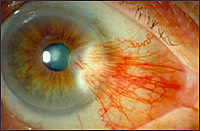 Pterygium is a growth that develops across the clear cornea of the eye. The pterygium is usually pink and fleshy and forms on the side of the eye nearest to the nose. This condition can cause discomfort and interfere with vision if the growth is allowed to continue.
Pterygium is a growth that develops across the clear cornea of the eye. The pterygium is usually pink and fleshy and forms on the side of the eye nearest to the nose. This condition can cause discomfort and interfere with vision if the growth is allowed to continue.
Symptoms of Pterygium
Sometimes, a pterygium causes no symptoms other than its appearance. A growing pterygium, however, may cause redness and inflammation. In some cases, a pterygium can grow onto the center of the cornea (the clear, outer layer of the eye covering the iris and pupil) and interfere with vision. It may also distort the shape of the cornea and cause a condition called astigmatism. The result can be blurred vision.
Symptoms of pterygium may include:
- Burning
- Gritty feeling
- Itching
- Sensation of a foreign body in the eye
- Blurred vision
Causes of Pterygium
It is not entirely clear what causes a pterygium to develop. But most experts believe that significant risk factors include:
- Prolonged exposure to ultraviolet light
- Dry eye
- Irritants such as dust and wind
Pterygium occurrence is much greater among people who live near the equator. But it also can develop in anyone who lives in a sunny climate. It’s most often seen in young adults aged 20 to 40. It appears to be more common in men than in women.
Pterygium often comes by a related noncancerous condition called pinguecula. This is a yellowish patch or bump on the conjunctiva near the cornea. The conjunctiva is the thin, moist membrane on the surface of the eye.

